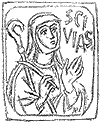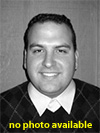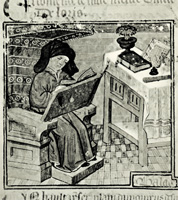medieval (400 - 1450)
Hildegard Of Bingen
 Hildegard of Bingen, considered a prophet by her contemporaries, was a Benedictine abbess, writer, and composer. Her accomplishments and her standing are extraordinary, particularly as she remains virtually the only known female figure of her time who achieved such intellectual stature and whose contributions have had lasting impact.
Hildegard of Bingen, considered a prophet by her contemporaries, was a Benedictine abbess, writer, and composer. Her accomplishments and her standing are extraordinary, particularly as she remains virtually the only known female figure of her time who achieved such intellectual stature and whose contributions have had lasting impact.
Guillaume Du Fay
 Guillaume Du Fay was a well-connected and influential composer who served as a bridge between the Medieval and the Renaissance periods. He is closely associated with one of history’s most influential melodies, L’homme armé, which refers to the need for every man to arm himself against some (unnamed) threat. The melody was used as one voice of the chanson Il sera pour vous/L’homme armé. Some scholars have concluded that Du Fay wrote the song, but other candidates are Robert Morton and Antoine Busnoys. In any case, Du Fay and many other composers of the day wrote masses based on the song, and it continued to be popular for the next two hundred and fifty years. In fact, the most recent mass based on L’homme armé was written in 1999.
Guillaume Du Fay was a well-connected and influential composer who served as a bridge between the Medieval and the Renaissance periods. He is closely associated with one of history’s most influential melodies, L’homme armé, which refers to the need for every man to arm himself against some (unnamed) threat. The melody was used as one voice of the chanson Il sera pour vous/L’homme armé. Some scholars have concluded that Du Fay wrote the song, but other candidates are Robert Morton and Antoine Busnoys. In any case, Du Fay and many other composers of the day wrote masses based on the song, and it continued to be popular for the next two hundred and fifty years. In fact, the most recent mass based on L’homme armé was written in 1999.
John Dunstable
 John Dunstable (or Dunstaple) is widely given credit for changing the face of music between the Middle Ages and the Renaissance by introducing new, “sweeter” harmonies. In addition, he was probably the first English composer to have a substantial influence upon continental European music.
John Dunstable (or Dunstaple) is widely given credit for changing the face of music between the Middle Ages and the Renaissance by introducing new, “sweeter” harmonies. In addition, he was probably the first English composer to have a substantial influence upon continental European music.
Magister Leoninus
During his lifetime, Leoninus wrote both poetry and music. Among his accomplishments as a poet was the setting of the first eight books of the Old Testament as hexametric verse. However, today he is chiefly remembered for his contributions as a composer of polyphonic liturgical music. While most composers of this genre were anonymous, Leoninus is credited with having written the Magnus liber organi (The Great Book of Organum), a work that notated Leoninus’s sacred polyphonic compositions and which greatly influenced western musical practices for the next several hundred years.
Guillaume de Machaut
 The status Machaut achieved in the fourteenth century was relatively unprecedented and comparable only to that of the older composer Philippe de Vitry. Most other musical works of the time were transmitted anonymously, and we know little or nothing about their composers today. In contrast, Machaut and his works were famous. Both his poems and his musical compositions were known throughout Europe during his lifetime, their style and technique remaining models for at least forty years after his death. In addition, he occupies a special place in music history as being the first composer to write a complete, unified musical setting of the Mass Ordinary.
The status Machaut achieved in the fourteenth century was relatively unprecedented and comparable only to that of the older composer Philippe de Vitry. Most other musical works of the time were transmitted anonymously, and we know little or nothing about their composers today. In contrast, Machaut and his works were famous. Both his poems and his musical compositions were known throughout Europe during his lifetime, their style and technique remaining models for at least forty years after his death. In addition, he occupies a special place in music history as being the first composer to write a complete, unified musical setting of the Mass Ordinary.
Philippe de Vitry
Philippe de Vitry was a composer and theorist whose work influenced the compositional practices of many subsequent generations. Perhaps most well known for a treatise on the “New Art” of his time, his motets also exhibit the earliest known use of isorhythm in the motet tenor.